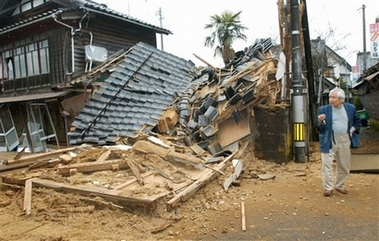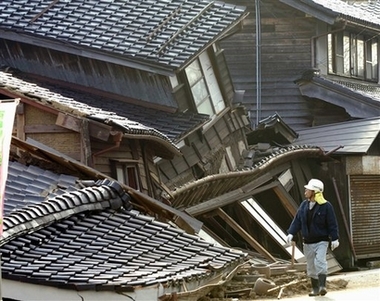Asia-Pacific
1 dead, 162 injured in Japan quake
(AP)
Updated: 2007-03-25 20:00
 |
Large Medium Small |
TOKYO - A powerful, deadly earthquake struck Japan early Sunday, killing at least one person and injuring 162 others as it violently shook buildings and triggered a small tsunami that hit the coast, officials and media reports said.
 A man looks at a warehouse destroyed by a strong earthquake in Anamizu in Ishikawa prefecture (state), northern Japan, Sunday morning, March 25, 2007. [AP]  |
A small tsunami measuring 6 inches hit shore about 40 minutes after the quake, the agency said. The warning was lifted about an hour later.
Lower intensity temblors continued to strike the region throughout the afternoon. A strong temblor with a preliminary magnitude of 5.3 hit at 6:14 p.m., but there was no tsunami danger, the agency said.
The quake toppled buildings, triggered landslides, cut power, interfered with phone service, broke water mains and snarled public transportation. At least one person was killed and 162 others were hurt along the country's Sea of Japan coast, media reports said.
Fear of aftershocks and more landslides caused by the loosening of soil waterlogged by overnight rains continued to plague the quake zone.
 A man walks past a destroyed house in Wajima in Ishikawa prefecture (state), northern Japan, Sunday afternoon, March 25, 2007. A powerful earthquake struck the area Sunday morning, killing at least one person and injuring 160 others as it damaged buildings and triggered a small tsunami along the coast, officials and media reports said. [AP] |
Many of the injured people suffered burns or were hurt by falling objects and broken glass, media reports said.
Chief Cabinet Secretary Yasuhisa Shiozaki confirmed the death as a 52-year-old woman. Public broadcaster NHK said she was crushed by a falling stone lantern.
"We are doing our best to rescue the victims," he said. "We are also doing our best to assess the extent of the damage."
The government will dispatch police and defense forces to the quake zone to assist in disaster relief, Shiozaki said.
Calls to police and prefectural officials in the region were not immediately answered.
"We felt violent shaking. My colleagues say the insides of their houses are a mess, with everything smashed on the floor," Wataru Matsumoto, deputy mayor of the town of Anamizu near the epicenter, told NHK.
Takeshi Hachimine, seismology and tsunami section chief at the Meteorological Agency, said the affected region was not considered a quake-prone area. The last major quake that caused deaths there was in 1933 when three people died.
He warned that after aftershocks are expected.
"After the powerful earthquake, aftershocks will continue," Hachimine said. "All residents, especially those who are near the hardest-hit areas, are advised to use extra caution. Aftershocks could further damage what's been already fragile."
Train service in Ishikawa and nearby Toyama prefecture was suspended and All Nippon Airways flights between Ishikawa and Tokyo were delayed, Kyodo News agency said.
Nuclear power plants owned by Tokyo Electric Power Co. and Kansai Electric Power Co. were operating normally in Niigata and Fukui prefectures, Kyodo said.
Japan sits atop four tectonic plates and is one of the world's most earthquake-prone countries. The last major quake to hit the capital of Tokyo killed some 142,000 people in 1923, and experts say the capital has a 90 percent chance of suffering a major quake in the next 50 years.
In October 2004, a magnitude-6.8 earthquake hit northern Japan, killing 40 people and damaging more than 6,000 homes. It was the deadliest to hit Japan since 1995, when a magnitude-7.2 quake killed 6,433 people in the western city of Kobe.
| 分享按钮 |